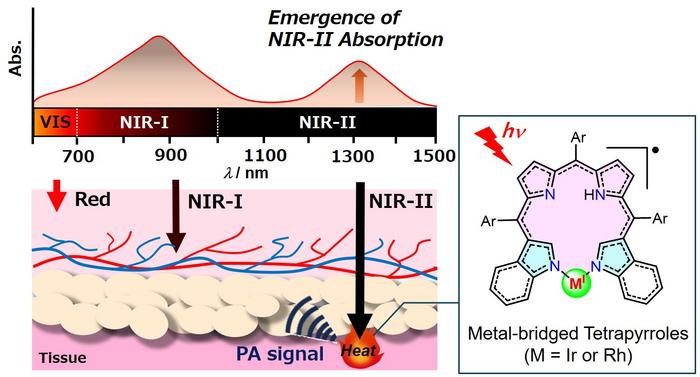In a groundbreaking study from Tokyo Metropolitan University, a team of researchers has unveiled a revolutionary dye engineered to absorb second near-infrared (NIR) radiation and convert it into heat. This innovative compound, inspired by bile pigments, possesses the capability to enhance the effectiveness of medical imaging and treatment techniques by utilizing wavelengths that can penetrate deep into human tissues. Such advancements hold the potential to transform the landscape of therapeutic applications, particularly in the realm of cancer diagnostics and treatment.
The dye developed by the researchers belongs to the bile pigment family and has undergone meticulous modification to improve its properties. Through a technique known as N-confusion chemistry, scientists altered the molecular structure of the original dye, bilatriene, allowing it to selectively bind metal ions like rhodium and iridium. This remarkable transformation not only increased the dye’s absorption capabilities but also significantly improved its photostability, enabling it to withstand prolonged exposure to light without degradation, a crucial trait for its practical application in medical settings.
Photoacoustic imaging leverages the unique properties of light absorption to generate diagnostic signals. When a contrast agent absorbs near-IR light, it instigates a thermal response that produces ultrasonic waves, allowing for the visualization of internal structures. This is particularly useful in oncology, where precise imaging of tumors is paramount for effective diagnosis and treatment planning. The new dye’s exceptional absorption at 1600 nanometers positions it as a formidable candidate for improving the sensitivity and resolution of photoacoustic imaging, which could lead to earlier cancer detection and more precise therapeutic interventions.
However, many existing contrast agents are predominantly sensitive to the first near-IR range, limiting their effectiveness in deep tissue imaging. By developing this novel dye capable of strong absorption in the second near-IR range, the researchers have addressed a significant gap in the availability of stable and efficient imaging agents. This advancement holds promise not only for cancer treatment but also for other medical fields requiring deep tissue visualization and analysis.
The study’s findings reveal that the dye achieves its impressive absorptive capabilities through a complex distribution of electrons within its pi-radicaloid structure. This unique electron configuration facilitates heightened interactions with the incoming near-IR light, allowing for effective thermal energy conversion. The implications of this discovery extend far beyond imaging; they suggest potential applications in the development of targeted therapies that utilize heat generation to selectively damage malignant cells while sparing surrounding healthy tissue.
Additionally, the photostability of the new dye enables repeated use in medical settings without the concern of degradation over time. This characteristic is critical, as many compounds that exhibit strong absorption may not maintain their stability under continuous light exposure. The ability to utilize this dye for multiple imaging sessions or treatments could significantly reduce costs and enhance the overall efficacy of treatment regimens.
The team’s research was supported by various grants, highlighting the importance and potential impact of this work within the scientific community. The collaborative effort underscores the commitment of institutions like Tokyo Metropolitan University to advance the field of medical science through innovative research. As the field continues to evolve, the integration of such novel compounds into therapeutic frameworks could address long-standing challenges in medical imaging and treatment delivery.
In conclusion, the development of this new dye marks a pivotal advancement in the pursuit of effective deep tissue imaging and therapy. With its unparalleled absorption properties and photostability, this innovative compound paves the way for improved methodologies in diagnosing and treating severe illnesses, particularly cancer. The ongoing exploration of second near-IR applications could fundamentally change how clinicians visualize and interact with complex biological systems, ultimately leading to better patient outcomes.
As researchers continue to investigate the full potential of this groundbreaking compound, the horizon of deep tissue medicine seems more promising than ever. The introduction of such advanced technology could usher in a new era in medical diagnostics and therapy, with far-reaching implications for patient care and treatment effectiveness. This exciting development represents just the beginning of what promises to be a transformative journey in the field of biomedical research.
Subject of Research: Development of a new dye for deep tissue imaging and therapy
Article Title: Metal-Bridging Cyclic Bilatriene Analogue Affords Stable π-Radicaloid Dyes with Near-Infrared II Absorption
News Publication Date: 10-Dec-2024
Web References: http://dx.doi.org/10.1002/anie.202418751
References: [Placeholder for specific references]
Image Credits: Credit: Tokyo Metropolitan University
Keywords: NIR-II Absorption, Photoacoustic Imaging, Cancer Diagnosis, Medical Imaging, Thermal Therapy, Electron Distribution, Bile Pigment, Photostability, Radicaloid Structures, Biomedical Research, Deep Tissue Applications, Contrast Agents.
Tags: bile pigment-inspired compoundscancer treatment advancementsdeep tissue penetration in imagingenhanced medical imaging techniquesinnovative cancer diagnostics technologiesmolecular structure alteration in dyesN-confusion chemistry in dye modificationnear-infrared dye for diagnosticsphotostability in medical dyesphotothermal cancer treatmentsecond near-infrared radiation applicationsTokyo Metropolitan University research breakthroughs





